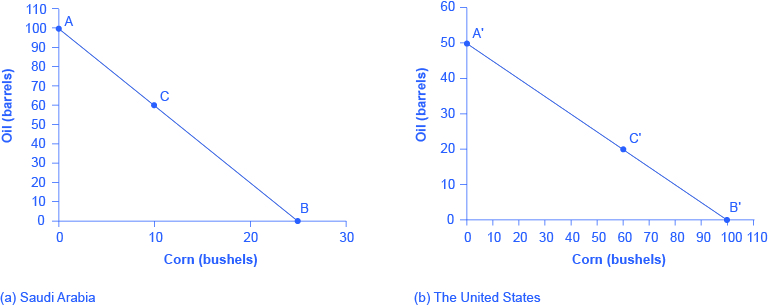| << Chapter < Page | Chapter >> Page > |
Visit this website for a list of articles and podcasts pertaining to international trade topics.
Consider a hypothetical world with two countries, Saudi Arabia and the United States, and two products, oil and corn. Further assume that consumers in both countries desire both these goods. These goods are homogeneous, meaning that consumers/producers cannot differentiate between corn or oil from either country. There is only one resource available in both countries, labor hours. Saudi Arabia can produce oil with fewer resources, while the United States can produce corn with fewer resources. [link] illustrates the advantages of the two countries, expressed in terms of how many hours it takes to produce one unit of each good.
| Country | Oil (hours per barrel) | Corn (hours per bushel) |
|---|---|---|
| Saudi Arabia | 1 | 4 |
| United States | 2 | 1 |
In [link] , Saudi Arabia has an absolute advantage in the production of oil because it only takes an hour to produce a barrel of oil compared to two hours in the United States. The United States has an absolute advantage in the production of corn.
To simplify, let’s say that Saudi Arabia and the United States each have 100 worker hours (see [link] ). We illustrate what each country is capable of producing on its own using a production possibility frontier (PPF) graph, shown in [link] . Recall from Choice in a World of Scarcity that the production possibilities frontier shows the maximum amount that each country can produce given its limited resources, in this case workers, and its level of technology.
| Country | Oil Production using 100 worker hours (barrels) | Corn Production using 100 worker hours (bushels) | |
|---|---|---|---|
| Saudi Arabia | 100 | or | 25 |
| United States | 50 | or | 100 |

Arguably Saudi and U.S. consumers desire both oil and corn to live. Let’s say that before trade occurs, both countries produce and consume at point C or C'. Thus, before trade, the Saudi Arabian economy will devote 60 worker hours to produce oil, as shown in [link] . Given the information in [link] , this choice implies that it produces/consumes 60 barrels of oil. With the remaining 40 worker hours, since it needs four hours to produce a bushel of corn, it can produce only 10 bushels. To be at point C', the U.S. economy devotes 40 worker hours to produce 20 barrels of oil and the remaining worker hours can be allocated to produce 60 bushels of corn.

Notification Switch
Would you like to follow the 'Principles of economics' conversation and receive update notifications?